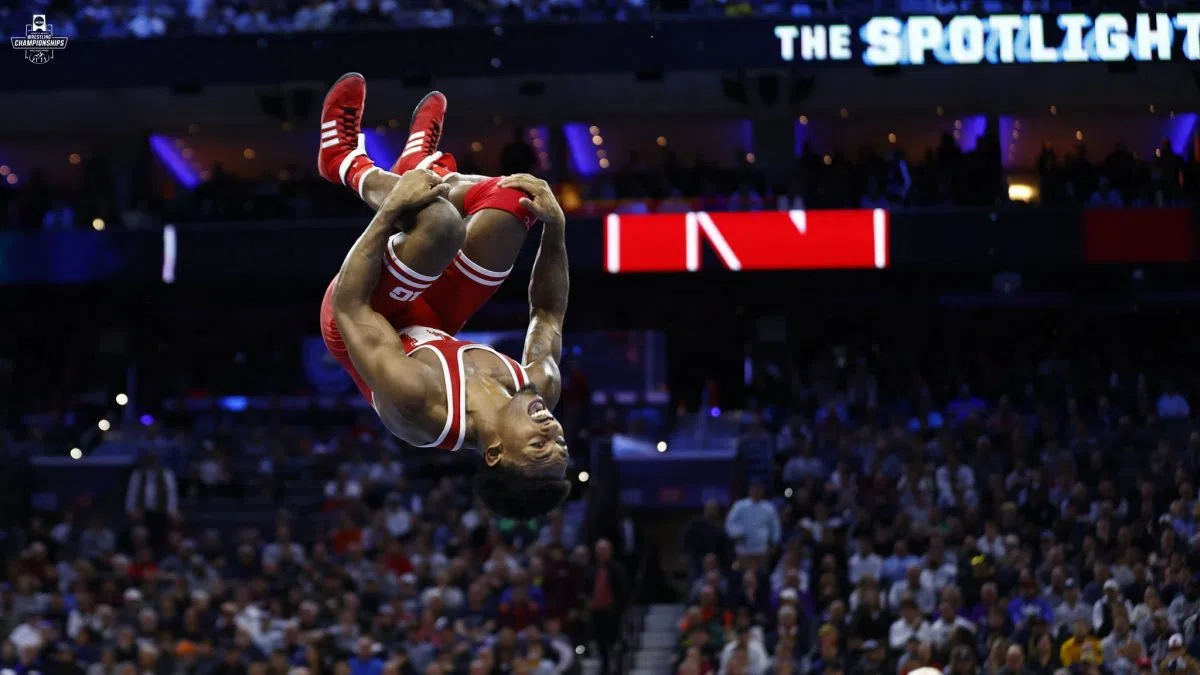Nebraska
Committee holds hearing on foreign-owned land in Nebraska, mulls changes
/cloudfront-us-east-1.images.arcpublishing.com/gray/Q4Z4YTSE2FCH3ODPAHTNEOX36M.jpg)
LINCOLN, Neb. (KOLN) – It’s an issue that hits close to home for many farmers and ranchers across the state: Who exactly is working the land next door?
Back in 1889, Nebraska passed a law limiting foreign ownership and leases of land, but today at a public hearing on an interim study, legislators asked if the law on the books goes far enough to rein in foreign powers, especially as tensions between the United States and China rise.
A federal report shows about 1.7% of all farm and ranch property in the state is foreign owned, but largely that’s not out in rolling corn fields. Foreign investment mostly comes into play on wind and solar farms, and that’s usually leasing, not owning. Right now, experts said that shouldn’t raise the alarm.
“There are no big numbers to suggest that we have any obvious economic impacts or concerns at this point,” said Brad Lubben, agricultural economist.
State Senator Steve Halloran, the Agriculture Committee chair, noted the vast majority of foreign ownership comes from U.S. allies. China comes in 18th.
“My concern is primarily to look at preventing a future problem with foreign ownership or investors in farm land,” Halloran said. “I don’t want it to become something that in the future people will look back and say, ‘We should have done something.’”
Halloran said it’s worth looking into a law that dates back more than 130 years, giving a largely toothless artifact some staying power.
“You can have all the laws on the books, but if you don’t have a sheriff enforcing them, then you have a problem,” Halloran said. “We need to look at the enforcement side of our laws.”
At issue for many farmers and some attendees of Friday’s hearing, like Edison McDonald, is large-scale ownership in general. For corporations and foreign powers, strategic goals can matter more than land and nearby community.
“If you’re focused on the next quarter, you may go and really over-work that land and not have a real long-term thought process about that sustainability,” McDonald said.
Halloran said he plans to pursue legislation on foreign land ownership in the upcoming legislative session.
Copyright 2023 KOLN. All rights reserved.

Nebraska
Falcons Showing Draft Interest in Nebraska Tight End

The Atlanta Falcons’ latest stop on the 2025 NFL draft pro day circuit was Lincoln, Nebraska, where Cornhuskers tight end Thomas Fidone II continued his strong pre-draft cycle.
Fidone, who stands 6’5″ and 243 pounds, met with the Falcons on Monday, the night before his pro day, according to Sportskeeda. Atlanta currently does not have an official visit or private workout scheduled with Fidone.
At the NFL combine, Fidone ran a 4.7 40-yard dash, notched a 35.5-inch vertical jump and reached 10-feet, six-inches in the broad jump. He paired his strong athletic testing with smooth movements during his on-field workout.
The 22-year-old Fidone played in only one game in his first two years at Nebraska due to separate knee injuries. His first dose of extended action came in 2023, when he led the team with four touchdown catches and logged 25 receptions for 260 yards across 12 games, eight of which were starts.
Fidone, a native of Council Bluffs, Iowa, caught 36 passes for 373 yards. He made multiple grabs in 10 of his 13 appearances.
Here’s NFL.com’s scouting report on Fidone:
“Fidone is long and linear with impressive athleticism but just two years of game experience due to injuries over his first two seasons,” writes Lance Zierlein. “He’s a willing blocker with pretty good technique but needs to add strength to handle the work in-line. He needs to become more elusive with his release and more physical at the catch point, but he’s fast and fluid through his routes.
“He has the ability to uncover and stress the defense beyond the first level. Fidone’s effort, athleticism and ability to improve a passing game give him a chance to become a TE2 in the NFL.”
The Falcons are in the market for a reserve tight end. Kyle Pitts and Charlie Woerner are both back on the roster, but Ross Dwelley remains an unrestricted free agent, leaving a vacancy at the team’s No. 3 tight end spot.
Perhaps Fidone, who’s raised his stock during the pre-draft prospect, will help fill the hole on Day 3.
Nebraska
As spring practice begins, Nebraska football wants to dispel these 4 narratives

LINCOLN, Neb. — Nebraska returned to the practice field this week. And despite the shifting winds in college football, it’s not cutting names this spring from an oversized roster.
Not yet, anyway.
“I think of these first few days as classroom instruction,” coach Matt Rhule said Tuesday after the Huskers’ second of 15 March and April workouts. “A ton of teaching, a ton of installation.”
Yes, when the Huskers open the 2025 season in five months, they must carry a roster of 105 players. That’s pending approval next month of terms in the House v. NCAA settlement, which is set to bring revenue sharing and changing roster limits to college sports.
For now, the Huskers are OK with 126 players in spring practice. Seven more incoming freshmen remain on track to join the group this summer.
The impending cutdown looms. But among the 26 defensive backs, discussion has stayed minimal on the subject of a reduced roster, senior safety Marques Buford said.
“Everybody’s coming in and working their butts off every day to prove that they belong here and prove that they should be on this team,” Buford said. “Every guy in our room has the potential to be on this team in the fall.
“And honestly, that sucks that we can’t bring everybody with us. But at the end of the day, that’s where the game of college football is going. We have to accept that.”
Rhule said he does not have a depth chart this early in spring.
“It’s not the coach’s job right now to figure out who’s going to play and who’s not going to play,” Rhule said. “It’s our job to figure out who can play.”
According to Ty Robinson, the defender whose eligibility expired in December, Rhule’s teaching attitude elevates the program. It helped convince Robinson to return in 2024 as a graduate student for his sixth season.
Robinson’s strong play earned him an invite to the NFL combine, at which he impressed scouts by running a 4.83-second 40-yard dash — fastest among defensive linemen — at 6-foot-5 and 288 pounds. He met with more NFL evaluators on Tuesday at Nebraska’s pro day.
“I represent Nebraska through and through,” Robinson said. “I’m proud to say that I played at Nebraska. All these scouts I’ve talked to, I’ve made them aware of how great Nebraska is – and how it’s honestly under the radar.”
2025 Nebraska Football Pro Day
Live from Lincoln, Nebraska https://t.co/2uK06Rmxvh
— Nebraska Football (@HuskerFootball) March 25, 2025
Robinson looks to lead a draft class at Nebraska in April that exceeds three players for the first time since 2016. It’s a myth, he said, that the Huskers’ talent is down.
“It’ll be a gold mine here pretty soon,” Robinson said.
In the spirit of spring narratives, here are four that the Huskers are aiming to dispel.
1. Nebraska needs a running back from the transfer portal. Not so, according to Rhule. “I have no concerns at running back,” he said.
Emmett Johnson, the junior who has rushed for 1,008 yards in the past two seasons, leads the group. But the backs feature no additional experience of note.
Rhule has long spoken highly of third-year sophomore Kwinten Ives. He scored his first career touchdown on a 2-yard run in the Pinstripe Bowl. Ives simply needs an opportunity, Rhule said.
Redshirt freshman Mekhi Nelson is “dynamically explosive,” according to Rhule, with an edge that the coach loves. Rhule also mentioned walk-on Kenneth Williams and said that the Huskers are eager to get a look this spring at early enrollees Conor Booth and Jamarion Parker. Parker has bulked up from 175 pounds to more than 190 since January.
The coaching staff will assess the running back lineup after spring practice, but Rhule anticipates standing pat.
“We’ve got guys that we know can play,” he said.
Coach Matt Rhule has “no concerns” with his running back room, which includes junior Emmett Johnson. (Dustin Satloff / Getty Images)
2. Dylan Raiola is out of shape. Commenting on the importance of adding an element of escapability to Raiola’s game, Rhule said two weeks ago that the sophomore “won’t be a great quarterback at 240 pounds” and that he was working on his body composition.
It caused a stir, leading to speculation that Raiola had gained weight above his listed 230 pounds. The coach clarified on Tuesday. “I said he knows he can’t be 240. I didn’t say he was 240.”
Raiola threw to the Nebraska wide receivers at pro day, looking fit and stronger than in his final appearance last season. He’s practiced well this week, Rhule said, and the QB has focused this offseason on maintaining a good weight.
“He’s done a really nice job with his body,” Rhule said.
3. Name, image and likeness and revenue-sharing payments are spinning out of control. You can believe that, Rhule said. But you might be wrong.
“The hardest thing right now is (that) I still don’t know the rules, the parameters,” Rhule said.
If approved, the House settlement would allow athletic departments to use up to $20.5 million in revenue sharing to pay athletes. As much as 70 percent of that figure could fund a salary pool for football players. But outside of revenue-share dollars, the future of NIL payments is uncertain.
The settlement includes language that would require third-party NIL deals above $600 to pass through an NCAA clearinghouse. It’s a stipulation that could significantly limit the earning power of football players beyond their revenue-sharing checks.
“You (could) no longer just stockpile players through money,” Rhule said.
An effective cap, even at roughly $14 million per team, would even the playing field among power programs.
“There’s a lot of schools that have benefited from unlimited bank accounts,” Rhule said. “If it’s limited, then it changes everything.”
4. Recruiting for 2026 has lost direction. Nebraska counts three commitments for the Class of 2026, ranking 40th nationally and 12th in the Big Ten, according to the On3 industry average.
The Huskers hosted a junior day on Feb. 1, but developments have been slow to get rolling among the next group of Nebraska recruits.
“We are probably just being very measured right now in trying to figure out how exactly this goes,” Rhule said.
Why? Again, follow the money.
“If you’re a coach who doesn’t care about saying something and then having to go back on it,” Rhule said, “it’s really a great time.”
For instance, Rhule said, he won’t allow himself to get in a situation where a player is promised $700,000 to come to Nebraska — but he shows up and gets $50,000 because rules didn’t permit the school to exceed that number.
“It’s a hard time to make a lot of promises,” the coach said.
Presumably, in April, more direction will arrive on revenue sharing, along with clarity on third-party NIL payments. For now, Rhule said, “it’s a time of great uncertainty.”
Nebraska won’t get left behind in this recruiting cycle, Rhule said. Its methods are by design.
“We’re prepared to have great June visits,” Rhule said. “And then we’re prepared to recruit all the way up until signing day — and be as aggressive as anybody in the country.”
(Top photo of Dylan Raiola: Dustin Satloff / Getty Images)
Nebraska
A breakthrough cancer therapy treatment is coming to Nebraska Medicine

OMAHA, Neb. (KMTV) — A breakthrough cancer therapy treatment is coming to Omaha. Construction for the project will start next week at the Buffett Cancer Center.
BROADCAST TRANSCRIPT:
Proton therapy uses extremely targeted radiation to attack tumors.
Kyle Skiermont, vice president of operations for Nebraska Medicine says this technology minimizes the damage to surrounding tissue and reduces side effects.
“We will be the first proton therapy treatment center in about a 6-state area,” Skiermont said. “We are hoping that patients are able to get this groundbreaking therapy while being able to stay much much closer to home.”
The therapy can used for various types of cancer, but is ideal for tumors close to the heart, brain, spine, and eyes, as well as pediatric patients. They will treat 300 to 400 patients a year with the technology, with the ability for more.
While construction will start soon, the therapy won’t be available for patients until spring of 2027.
-

 News1 week ago
News1 week agoTrump Administration Ends Tracking of Kidnapped Ukrainian Children in Russia
-

 News1 week ago
News1 week agoVance to Lead G.O.P. Fund-Raising, an Apparent First for a Vice President
-

 Business1 week ago
Business1 week agoEgg Prices Have Dropped, Though You May Not Have Noticed
-

 World1 week ago
World1 week agoCommission warns Alphabet and Apple they're breaking EU digital rules
-

 News1 week ago
News1 week agoTrump’s Ending of Hunter Biden’s Security Detail Raises Questions About Who Gets Protection
-

 Technology1 week ago
Technology1 week agoCFPB workers are reinstated after a court order, but many still can’t work
-

 Technology1 week ago
Technology1 week agoChip race: Microsoft, Meta, Google, and Nvidia battle it out for AI chip supremacy
-

 News1 week ago
News1 week agoU.S. to Withdraw From Group Investigating Responsibility for Ukraine Invasion



















